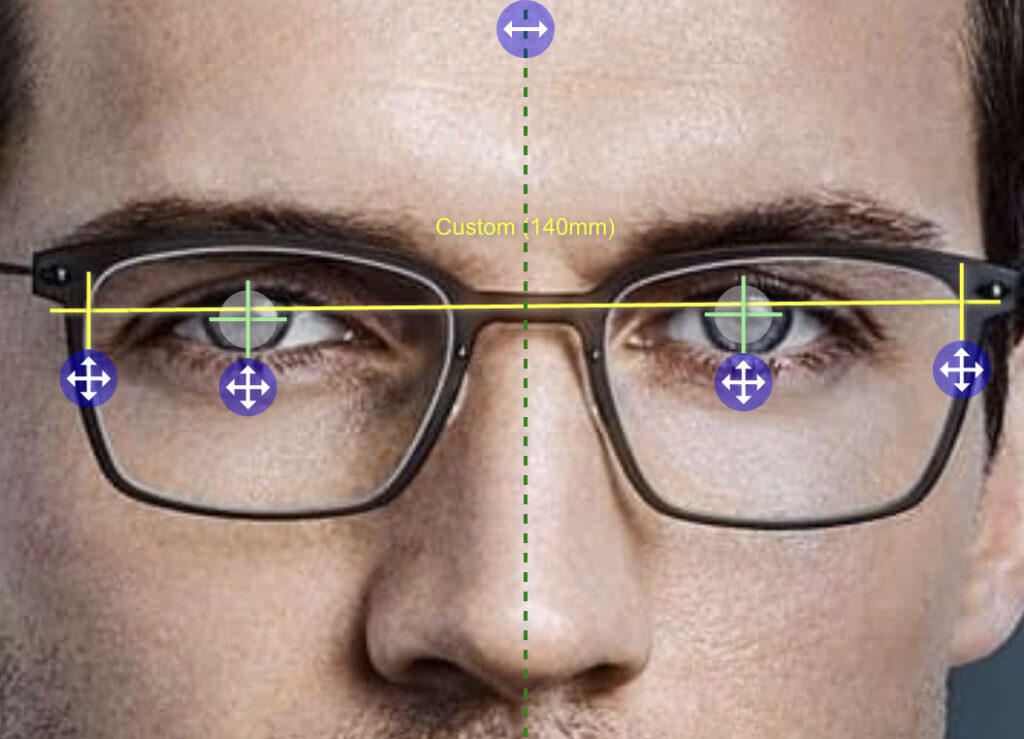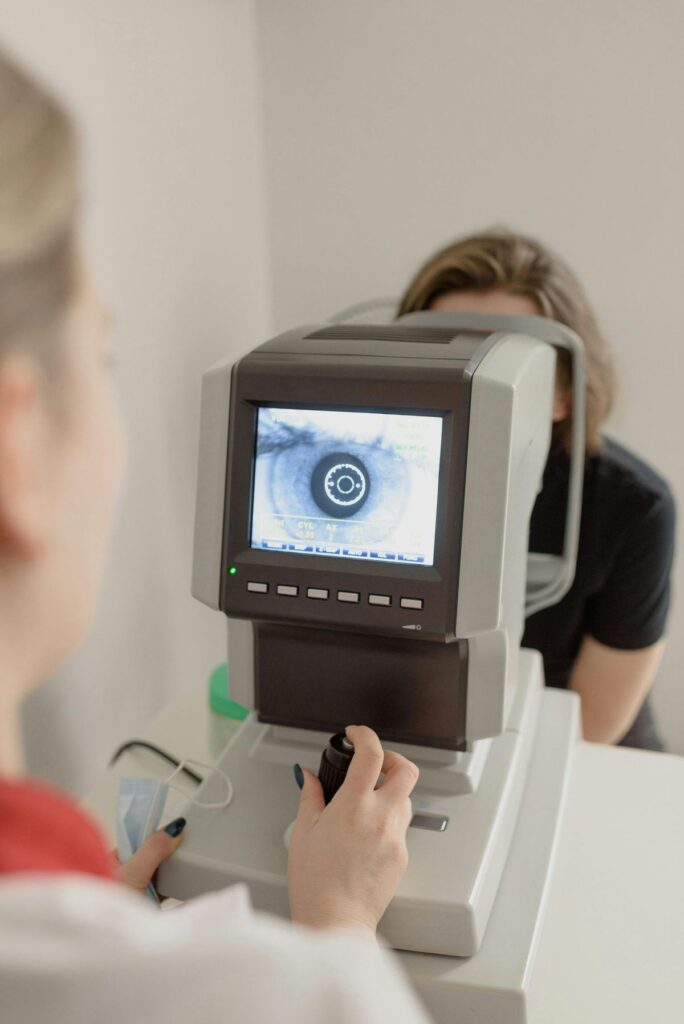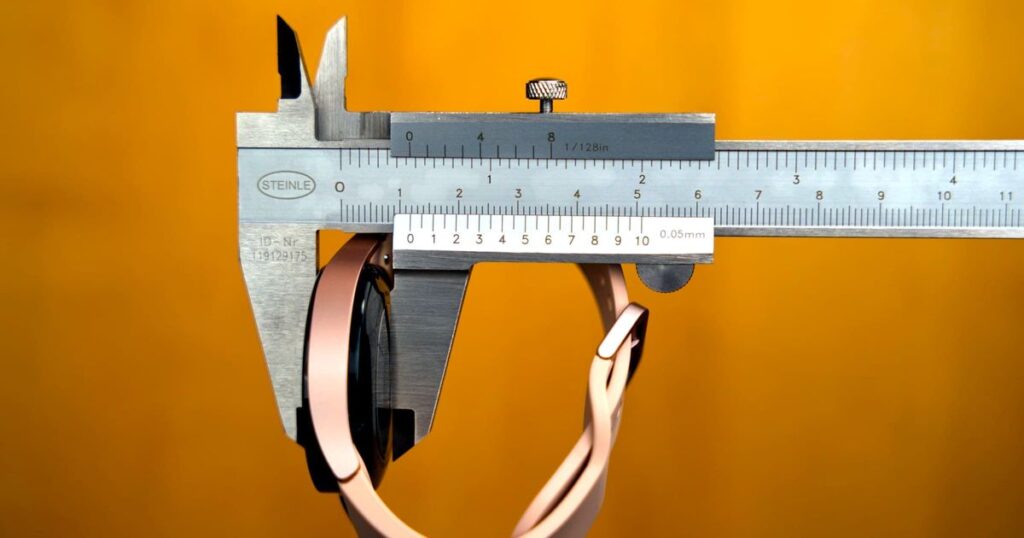In the dynamic field of eye care, the digital PD (pupillary distance) ruler represents a significant technological advancement, reshaping the way professionals measure pupillary distance with enhanced precision and ease. This article delves into the emergence of digital PD rulers, their integration into clinical practice, the broader technological advancements they signify in eye care, the role of data registries like the IRIS Registry in fostering innovation, and the challenges faced in adopting these digital tools.
Key Takeaways
- Digital PD rulers have revolutionized pupillary distance measurement by providing greater accuracy and reliability compared to traditional methods.
- The adoption of digital PD rulers in clinical practice has improved the patient experience and has been supported by success stories in various clinical settings.
- Technological advancements, including the use of AI and machine learning, are propelling the field of ophthalmology into a new era of precision and personalized care.
- The IRIS Registry has become a pivotal resource in ophthalmology, leveraging big data to drive research, insights, and innovations in eye health.
- Challenges such as overcoming skepticism, addressing regulatory and privacy concerns, and ensuring equitable access must be navigated for the wider adoption of digital PD tools.
Understanding the Digital PD Ruler

The Evolution of Pupillary Distance Measurement
The measurement of pupillary distance (PD) has undergone a remarkable transformation over the years. From rudimentary tools to sophisticated digital solutions, the quest for accurate eye measurements has been a constant in the field of optometry. The digital PD ruler represents a significant leap forward in this evolutionary journey.
Traditionally, PD was measured manually, with optometrists using a millimeter ruler to gauge the distance between the centers of the pupils. This method, while straightforward, was prone to human error and lacked precision. The advent of digital technology brought about a new era of PD measurement tools that offer greater accuracy and ease of use.
The digital PD ruler not only simplifies the process but also ensures that measurements are consistent and replicable, a crucial factor in the creation of custom eyewear.
With the introduction of devices like the Optigrid, the industry has seen a paradigm shift. Optigrid revolutionizes optical measurements for eyeglasses businesses and optometrists with innovative features, user-friendly design, and precise measurements, setting a new standard in the industry.
How Digital PD Rulers Work
Digital PD rulers represent a significant advancement in the measurement of pupillary distance (PD), which is a critical parameter in prescribing eyeglasses and contact lenses. These tools utilize sophisticated algorithms and imaging technology to capture and calculate the distance between a person’s pupils with high precision.
The process typically involves the following steps:
- The user positions themselves in front of the digital PD ruler’s camera.
- The device prompts the user to look at a specific point to ensure proper alignment.
- The camera captures an image or video of the user’s face.
- Software analyzes the image to identify the pupils and measure the distance between them.
- The PD measurement is displayed to the user, often within seconds.
Digital PD rulers streamline the measurement process, reducing the potential for human error and providing quick and reliable results.
While traditional methods rely on manual tools and subjective judgment, digital PD rulers offer a more objective and standardized approach. This technology not only enhances accuracy but also improves the overall efficiency of the eye care process.
Accuracy and Reliability of Digital PD Tools
The quest for precision in pupillary distance (PD) measurement has led to the development of digital PD tools, which promise to enhance the accuracy of diagnoses and the fitting of eyewear. Research focuses on evaluating PD measurement tools for PPA diagnosis, emphasizing accuracy and technological advancements like Optigrid for eyewear businesses and healthcare applications.
Digital PD tools leverage advanced algorithms and computer vision technology to provide objective measurements. For instance, DeepLabCut has been utilized to track finger tapping in smartphone videos, correlating well with clinical ratings and demonstrating high accuracy with Spearman coefficients ranging from
-0.50 to -0.74 (p< .001).
The integration of digital PD tools in clinical practice is not without challenges, yet their potential to revolutionize eye care is significant. By providing consistent and precise measurements, these tools can greatly improve the diagnosis and treatment of conditions like Parkinson’s Disease (PD).
While the technology is promising, it is crucial to continuously assess the accuracy and reliability of these digital tools to ensure they meet the rigorous standards of medical practice.
The Integration of Digital PD Rulers in Clinical Practice

Adoption by Eye Care Professionals
The digital PD ruler is increasingly becoming a staple in optometric and ophthalmologic practices. Eye care professionals are embracing this technology for its ability to enhance precision in measuring pupillary distance, a critical factor in prescribing eyeglasses and contact lenses. Innovations in remote pupillary distance measurement include advanced portable PD meters and smartphone apps, improving accuracy and accessibility in optometry.
The adoption rate varies by region and practice size, with larger practices and urban centers leading the way. Here’s a snapshot of the current landscape:
- Urban practices: High adoption rates due to greater access to technology and patient demand
- Rural practices: Gradual adoption with increasing availability of affordable solutions
- University-affiliated clinics: Early adopters, often involved in research and development
- Independent optometrists: Adoption influenced by competitive pressures and patient expectations
The integration of digital PD tools is not just a technological upgrade but a paradigm shift in patient care. It streamlines the process, reduces errors, and ultimately leads to better patient outcomes.
Despite the clear benefits, some practitioners remain hesitant, citing concerns over cost and the learning curve associated with new technology. However, as digital solutions become more user-friendly and cost-effective, resistance is expected to wane, paving the way for widespread adoption.
Impact on Patient Experience
The advent of digital PD rulers has significantly enhanced the patient experience in eye care. Patients now enjoy a more streamlined and comfortable process for obtaining their pupillary distance measurements, which is essential for accurately fitting eyeglasses and contact lenses.
- Ease of use: Digital PD tools are user-friendly and can be operated with minimal instruction.
- Speed: The measurement process is quick, reducing the time spent in the optometrist’s office.
- Non-invasive: Unlike some traditional methods, digital PD rulers do not require physical contact, making the process more comfortable.
The integration of specialized EMR systems in ophthalmology has further improved efficiency for optometry practices, leading to shorter wait times and a more personalized care approach.
Patients also benefit from the accuracy and precision that digital PD rulers provide. This technology ensures that eyewear prescriptions are based on the most accurate data possible, leading to better visual outcomes and higher satisfaction rates.
Case Studies: Success Stories in Clinical Settings
The adoption of digital PD rulers in clinical settings has led to a number of success stories that highlight the potential of this technology in revolutionizing eye care. Clinicians have reported significant improvements in the accuracy of PD measurements, which in turn has enhanced the quality of vision correction provided to patients.
- A study comparing refractive outcomes after cataract surgery showed that the use of digital PD tools contributed to more precise lens fitting and patient satisfaction.
- The implementation of digital PD measurement has streamlined the workflow in ophthalmology clinics, reducing the time needed for each patient without compromising care quality.
- Eye care professionals have noted an increase in patient engagement and education, as digital tools facilitate better understanding and involvement in the treatment process.
The integration of digital PD rulers is not just a technological upgrade but a paradigm shift in patient-centered care, enabling personalized treatment plans and fostering trust between patients and eye care providers.
While these anecdotes are promising, it is important to continue monitoring the long-term impact of digital PD tools on clinical outcomes and patient satisfaction to ensure that the benefits are sustained over time.
Technological Advancements in Eye Care

From Manual to Digital: A Technological Leap
The technological revolution in the eyewear industry has marked a significant shift from manual methods to digital solutions in measuring pupillary distance (PD). This transition is not just about adopting new gadgets; it represents a fundamental change in how eye care professionals approach the fitting of prescription eyewear and personal protective equipment. The digital PD ruler simplifies the measurement process, improves patient experience, enhances lens fitting, reduces errors, and benefits the industry as a whole.
The digital age has ushered in a new era of biometrics, where the precision and ease of digital tools have become the new standard in eye care. This shift is reflective of a broader movement towards computerization across various sectors.
The adoption of digital PD rulers is a testament to the industry’s commitment to precision and patient satisfaction. It is a clear indication that the field of ophthalmology is not just keeping pace with technological advancements but is actively leveraging them to improve outcomes.
The Role of AI and Machine Learning
The integration of Artificial Intelligence (AI) and Machine Learning (ML) into eye care represents a significant shift towards more personalized and efficient patient care. AI and ML algorithms excel in recognizing patterns within large medical datasets, including ophthalmic biometrics, which is crucial for the development of precision medicine in optometry.
- AI-powered diagnostics facilitate early detection of eye conditions, enhancing treatment success rates.
- Machine learning models are instrumental in analyzing complex data, leading to innovative vision correction strategies.
- Deep Learning (DL) techniques, a subset of ML, are particularly adept at interpreting intricate patterns in medical imaging, such as retinal scans.
The potential of AI and ML in eye care extends beyond diagnostics to include predictive analytics, offering a proactive approach to managing eye health.
The adoption of these technologies in eye care not only streamlines the diagnostic process but also opens up new avenues for treatment. For instance, DL has shown promise in the detection of conditions through genetic analysis or advanced imaging techniques. As AI continues to evolve, it is imperative that model developers and regulatory entities work together to ensure accountability and consider the implications of AI-based decisions on patient outcomes.
Future Trends in Ophthalmic Biometrics
The landscape of ophthalmic biometrics is on the cusp of transformative change, driven by relentless technological progress. Technology advances enhance refraction measurement accuracy, leading to a future where artificial intelligence (AI) is seamlessly integrated into eye care practices. This integration promises not only heightened accuracy but also a more personalized approach to vision correction, ensuring that eyewear provides the utmost comfort and precise vision enhancement.
The market for digital identity solutions, which includes ophthalmic biometrics, is burgeoning. According to recent forecasts, the global biometric system market is expected to nearly double by 2027, indicating a robust trajectory for innovation in this field. Here’s a glimpse into the potential scale of growth:
The synergy between AI and machine learning with biometric technologies heralds a new epoch in eye care, where devices not only adapt to environmental conditions but also to the unique biometric signatures of each individual.
As we look to the horizon, the promise of advancements such as 3D facial recognition and multimodal biometric systems suggests a future where ophthalmic biometrics play a pivotal role in identity verification and health diagnostics. The evolution from simple measurement tools to complex, adaptive systems is a testament to the field’s dynamic nature and its potential to revolutionize eye care.
The Role of the IRIS Registry in Advancing Eye Care
Harnessing Big Data for Ophthalmology
The IRIS Registry has become a pivotal tool in ophthalmology, leveraging big data to transform patient care and research. By aggregating vast amounts of patient data, the registry aids in identifying trends, improving treatment protocols, and advancing clinical practices.
- Enhanced patient experiences
- Improved diagnostic accuracy
- Streamlined workflows
- AI integration for personalized treatment recommendations
The integration of the IRIS Registry into clinical settings has facilitated a more data-driven approach to eye care. Researchers and clinicians can now access a wealth of information that was previously unavailable, leading to more informed decision-making and better patient outcomes.
The potential of the IRIS Registry is immense, with its ability to uncover insights that can lead to breakthroughs in the treatment and management of eye diseases.
Case Analysis: IRIS Registry Insights
The IRIS Registry has become a cornerstone for ophthalmic research, providing a wealth of data that drives innovation and enhances clinical practice. Recent studies have leveraged the registry to replicate findings from pivotal clinical trials, confirming the reliability of real-world data in reflecting controlled research outcomes. For instance, the replication of VIEW 1 and VIEW 2 trials using IRIS data has been a significant milestone, demonstrating the registry’s potential in post-market surveillance and long-term safety studies.
The integration of the IRIS Registry into research has facilitated a deeper understanding of disease patterns and treatment efficacies across diverse populations.
The registry’s insights have also been instrumental in identifying trends and gaps in eye care, particularly in the context of the COVID-19 pandemic’s impact on outpatient visits and procedures. This has allowed for a more systematic approach to addressing disparities and improving patient outcomes. Below is a summary of key research facilitated by the IRIS Registry:
- VERANA HEALTH USES IRIS REGISTRY FOR GEOGRAPHIC ATROPHY RESEARCH
- MODELING FOR MISSING DATA
- EXACT MATCHING VS PROPENSITY SCORE WEIGHTING
- HIGHLIGHTS FROM THE 2022 IRIS REGISTRY REPORT
- DATA QUALITY CONSIDERATIONS FOR DETERMINING THE IMPACT OF COVID-19
The IRIS Registry continues to be a valuable asset for the ophthalmology community, enabling a data-driven approach to eye care that is both innovative and patient-centric.
Collaborations and Innovations Stemming from IRIS Data
The IRIS Registry has become a cornerstone for fostering collaborations and driving innovations in eye care. Data sharing initiatives have significantly reduced the proportion of subjects with missing demographic data, enhancing the quality of research outputs. The integration of ophthalmic imaging with clinical data has unlocked new potentials for comprehensive patient analysis.
- Optigrid, an online platform, leverages IRIS data to provide highly accurate optical measurements, revolutionizing eyeglass fittings for optometrists and ensuring safety standards for eyeglasses businesses and PPE eyewear.
- Studies like the emulation of the CATT trial using IRIS data exemplify the registry’s role in advancing clinical research methodologies.
The synergy between technology and big data analytics is paving the way for personalized eye care solutions and more effective treatment strategies.
The registry’s impact is evident in the growing number of studies utilizing its vast database, from research on diabetic retinopathy disease severity to trends in minimally invasive glaucoma surgery. These efforts underscore the transformative power of collaborative data in shaping the future of ophthalmology.
Challenges and Considerations for Digital PD Adoption

Overcoming Skepticism in the Medical Community
The adoption of digital PD rulers in eye care has been met with varying degrees of acceptance. Urban Optiks Optometry is at the forefront of this digital transformation, showcasing the potential of advanced technology to enhance precision and efficiency in optical care. However, not all practitioners are quick to embrace these new tools.
Skepticism among eye care professionals often stems from concerns about the accuracy of digital measurements and the potential loss of the personal touch in patient care. To address these concerns, it is crucial to demonstrate the reliability of digital PD tools through clinical evidence and peer-reviewed studies.
- Community-driven biometrics can play a role in fostering trust and acceptance.
- Cultural norms and historical experiences influence perceptions of privacy and technology adoption.
- Navigating these cultural variances is essential for global acceptance.
The future of eyewear retail is being shaped by optometrists who are willing to integrate new technologies into their practice, improving patient outcomes through personalized services.
Navigating Regulatory and Privacy Concerns
The deployment of digital PD rulers brings to the forefront privacy, data security, and ethical implications in our sensor-rich healthcare environments. As these tools collect sensitive biometric data, regulatory frameworks and privacy policies must evolve to ensure robust protection against misuse.
- Transparent data protection measures
- Access control mechanisms
- Clear communication with patients
These are essential components that must be addressed to foster trust and mitigate privacy concerns. Public perception is a delicate balance of trust and apprehension, and it is influenced significantly by how well these concerns are navigated.
Balancing the convenience of digital PD measurement with privacy apprehensions is a challenge that requires ongoing educational initiatives and transparent communication.
The integration of digital PD tools into clinical practice must be accompanied by a clear understanding of regulatory requirements and a commitment to patient privacy. This ensures that the benefits of these advanced tools do not come at the cost of compromising personal data security.
Ensuring Equitable Access to Digital Eye Care Tools
The advent of digital PD rulers promises to enhance the precision of eye care, but it also raises concerns about equitable access. Ensuring that these innovative tools benefit everyone, regardless of socioeconomic status, is crucial.
- Awareness: Educating the public about the benefits of digital PD measurement can drive demand and adoption.
- Affordability: Subsidies or tiered pricing models can make digital PD tools accessible to lower-income patients.
- Accessibility: Deployment in diverse settings, including remote areas, is essential to reach underserved populations.
- Training: Providing training for eye care professionals in all communities ensures the proper use of digital tools.
The challenge lies not only in developing cutting-edge technology but also in implementing systems that facilitate its reach to all corners of society. Without concerted efforts to address access disparities, the digital divide in eye care could widen, leaving the most vulnerable behind.
While the adoption of Digital PD (Professional Development) presents numerous benefits, it also comes with its own set of challenges and considerations. From ensuring accessibility to all educators to providing relevant and engaging content, the path to successful implementation requires careful planning and support. To navigate these complexities, visit our website and explore OPTIGRID, our comprehensive platform designed to streamline your digital PD journey. Sign in today to unlock a world of resources tailored to your professional growth.
Conclusion
The digital PD ruler represents a significant leap forward in the realm of eye care, offering precision, ease, and accessibility that traditional methods struggle to match. As we have seen throughout this article, the integration of digital tools into ophthalmology has been met with enthusiasm and success, as evidenced by the numerous studies and advancements documented in the IRIS Registry and other research. The pandemic has accelerated the adoption of remote monitoring and digital health technologies, further underscoring the importance of innovative solutions like the digital PD ruler. With the continued support of the American Academy of Ophthalmology and the ongoing research into minimally invasive procedures and digital health applications, the future of eye care looks bright. The digital PD ruler is not just a tool; it’s a symbol of the transformative potential of technology in enhancing patient outcomes and shaping the future of ophthalmic care.
Frequently Asked Questions
What is a Digital PD Ruler?
A Digital PD (Pupillary Distance) Ruler is a tool used to measure the distance between the centers of the pupils in each eye. This measurement is crucial for the correct fitting of eyeglasses and is increasingly being done digitally for accuracy and convenience.
How does a Digital PD Ruler improve clinical practice?
Digital PD Rulers provide eye care professionals with a more accurate and efficient way to measure pupillary distance. This enhances the patient experience by ensuring a precise fit for eyeglasses and may reduce the need for return visits for adjustments.
What role does AI play in the evolution of eye care tools?
Artificial Intelligence (AI) and machine learning are being integrated into eye care tools to analyze large datasets, improve diagnostic accuracy, personalize patient care, and predict outcomes. These technologies are at the forefront of the next generation of ophthalmic instruments.
How does the IRIS Registry contribute to advancements in eye care?
The IRIS (Intelligent Research in Sight) Registry is the world’s largest specialty clinical database, managed by the American Academy of Ophthalmology. It enables the collection and analysis of a vast amount of ophthalmic data, fostering research and driving innovations in the field.
What are the challenges in adopting Digital PD tools?
Challenges include skepticism from some medical professionals who are accustomed to traditional methods, navigating regulatory and privacy concerns, and ensuring that digital eye care tools are accessible to all patients regardless of socioeconomic status.
Can Digital PD Rulers be used remotely, and how has the pandemic affected their use?
Yes, Digital PD Rulers can be used remotely, and the COVID-19 pandemic has accelerated the adoption of such remote monitoring and testing tools. They enable patients to receive eye care services without the need for in-person visits, which is particularly valuable during times of social distancing.

I am a seasoned software engineer with over two decades of experience and a deep-rooted background in the optical industry, thanks to a family business. Driven by a passion for developing impactful software solutions, I pride myself on being a dedicated problem solver who strives to transform challenges into opportunities for innovation.
